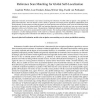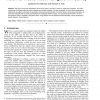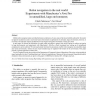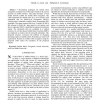RAS
2002
14 years 7 months ago
2002
Especially in dynamic environments a key feature concerning the robustness of mobile robot navigation is the capability of global self-localization. This term denotes a robot'...
PAMI
2002
14 years 7 months ago
2002
This paper surveys the developments of the last 20 years in the area of vision for mobile robot navigation. Two major components of the paper deal with indoor navigation and outdoo...
RAS
2000
14 years 7 months ago
2000
Mobile robot navigation under controlled laboratory conditions is, by now, state of the art and reliably achievable. To transfer navigation mechanisms used in such small-scale env...
JIRS
2007
14 years 7 months ago
2007
A real-time object tracking and collision avoidance method for mobile robot navigation is presented using stereo vision and a laser sensor. Stereo vision is used to identify the ta...
JIRS
2006
14 years 7 months ago
2006
Abstract. Autonomous mobile robot navigation systems are based on three principal kinds of techniques: map-based navigation, map-building-based navigation and mapless navigation. W...
AAAI
2000
14 years 8 months ago
2000
Self-localisation is an essential competence for mobile robot navigation. Due to the fundamental unreliability of dead reckoning, a robot must depend on its perception of external...
IJIT
2004
14 years 9 months ago
2004
Developing techniques for mobile robot navigation constitutes one of the major trends in the current research on mobile robotics. This paper develops a local model network (LMN) fo...
ROBOCUP
2000
Springer
14 years 11 months ago
2000
Springer
Self localization seems necessary for mobile robot navigation. The conventional method such as geometric reconstruction from landmark observations is generally time-consuming and ...
ICRA
1998
IEEE
14 years 11 months ago
1998
IEEE
: Laser scanners, or laser radars (ladar), have been used for a number of years for mobile robot navigation and inspection tasks. Although previous scanners were sufficient for low...
ICRA
2006
IEEE
15 years 1 months ago
2006
IEEE
— We present a novel, simple algorithm for mobile robot navigation. Using a teach-replay approach, the robot is manually led along a desired path in a teaching phase, then the ro...




